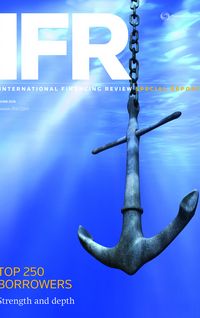Despite having to overcome a myriad of hurdles in the recent past, things are now looking brighter for Latin American debt markets.
Hammered by weakness in commodity markets and persistent concerns about US monetary policy tightening – not to mention a multitude of domestic woes – Latin American local currency debt has endured a gloomy few years.
Local currency bonds in Latin America were returning more than 10% in US dollar terms by mid-May, higher than any other emerging market region, according to a JP Morgan index. To put that performance in context, Latin American local currency bonds returned –21.69% in dollar terms last year.
Investors and bankers say the turnaround in fortunes has been down to three major shifts in the wider macro environment: fading US interest rate hike expectations, fewer concerns about China and the start of a commodity price recovery.
“First, oil bottomed, then the Fed became more dovish, and then China, after depreciating the currency a fair amount, stopped doing that,” said Dirk Willer, an emerging market strategist at Citigroup. “That gave us this rebound at a time when everybody was short [local currency bonds]. So the first leg of the rally was short-covering, but then people actually started going long.”
An improved domestic backdrop across much of the region has also helped asset prices recover. Brazil, for instance, is leading the pack amid optimism that the impeachment of president Dilma Rousseff following allegations of budget fiddling and the installation of a new market-friendly finance team by acting president Michel Temer will begin to reverse years of economic mismanagement.
Brazil’s local currency bonds were returning almost 30% in dollar terms by mid-May, according to the JP Morgan GBI-EM index – the best performing country in the entire emerging market local currency bond universe.
“There have really been two separate trades in Brazil,” said Willer. “One was the impeachment trade and that’s mostly done, and the market reaction was obviously very positive. The second one is the rate-cutting trade, which hasn’t even started yet. With interest rates at around 14% in the middle of a recession, Brazil has tremendous space to cut if inflation continues to fall, so we would expect this easing cycle to start in the summer.”
Investors are already pricing in around 200bp of rate cuts over the next 12 months, but twice as much as that will likely be needed, said Didier Lambert, an emerging market debt fund manager at JP Morgan Asset Management.
“You have a damaged economy that is running with a very high level of interest rate, so there is a need to relax monetary policy; rates are just too high for the economy to recover,” he said.
There is a similar story of political optimism unfolding in Argentina. Late last year, Mauricio Macri was elected president in the hope his centre-right government could help undo years of economic decline suffered under previous incumbent Kristina Fernandez de Kirchner’s leftist regime.
“They’ve replaced Kirchner with probably the strongest economic team in Latin America,” said Jan Dehn, head of research at Ashmore Investment Management. “They face a big challenge, but the Argentinean peso is rallying. I can’t remember the last time anybody wanted to have a long bet on the Argentinean peso, but that’s what people are doing now. It’s really a huge change.”
The financial incentive for backing Argentina’s recovery is clear, even if the outcome is uncertain given the scale of the task ahead to bring down inflation, cut the fiscal deficit and revive growth, said Lambert.
“When you invest in anything less than one year in Argentine peso you get paid around 30%. You take risk, but you have a significant cushion to take that risk if you assume that the situation and the currency will remain stable,” he said. “Argentina is the one where you are investing more in hope, because there are a lot of unknowns.”
While Argentina is not in the JP Morgan bond index, most local currency debt buyers benchmark against other Latin American countries that are also offering chunky returns. A rally in Peruvian local bonds had pushed up dollar returns to almost 14% by mid-May; Colombia, meantime, was returning close to 9%.
“Latin America is an attractive region now,” said Ricardo Adrogue, head of emerging market debt at Babson Capital Management. “Differentiation is important but it is less important than it was a year or two ago when the path of Latin American countries was more divergent. Today, the paths tend to be converging to relatively good economic policies.”
That political lurch to the right and the adoption of more market-friendly economic policies has taken some investors by surprise.
“In previous periods when the Latin American region went through difficult times, usually we have seen a more political move towards the left,” said Viktor Szabo, an emerging market debt fund manager at Aberdeen Asset Management. “That’s something unexpected from a longer term macro perspective – after trying the left and failing, now they are moving towards the right and the market, which is quite encouraging.”
Mexican conundrum
But adopting more market-friendly policies does not always translate into better performance. Mexico, for instance, which has embarked on a whole raft of economic reforms, is the worst performer in the JP Morgan GBI-EM index. It was returning almost –4.5% in dollar terms by mid-May, something that is baffling investors.
“We like Mexico’s economic fundamentals and we like the policy-making but we are really puzzled why the asset price is not reflecting the relative strength of those fundamentals,” said Szabo.
Szabo reckons one reason for its weak performance could be that many investors use the Mexican peso as a hedge against broader emerging market risk because it is very liquid and therefore cheaper to trade. Emerging market bond investors have also been mostly overweight Mexico, another potential reason why the country has lagged the rest of the region where positioning going into this year was relatively light, said Stuart Ritson, an emerging market debt fund manager at Aviva Investors.
Both Szabo and Ritson are betting on Mexico’s bonds to recover.
“We think there’s about 75bp of rate hikes priced into the yield curve and we view that as probably being a bit too much, so there’s opportunities for that to be priced out at some point,” said Ritson.
Yet despite the wider optimism, a number of risks lurk in the background. Ritson said monetary policy expectations in Brazil are now firmly embedded in short-dated bond prices and could prove overly bullish.
“The performance over the last two months has been set against a reasonably favourable external backdrop,” he said. “Should the currency come under pressure again or should the Federal Reserve expectations move again, some of these optimistic outcomes that are priced into the curve for Brazil may not come to fruition.”
Those Fed concerns have partially resurfaced given something of an improved run of US economic data and recent hints from Fed chairwoman Janet Yellen that a rate rise could be on the cards in the coming months.
“We feel the Fed is likely to hike one or two times this year, which currently isn’t priced in, so there is probably room for some degree of volatility around these markets if our Fed expectations are correct,” said Ritson.
Further setbacks in China could also derail the rally in Latin American assets, given the region’s dependence on commodity exports. But if any of those macro concerns do re-emerge, the impact is likely to be uneven.
“A slowdown of copper imports from China, if you start to factor in a relapse of growth, would [have a greater impact on] countries like Chile and also Peru,” said JPAM’s Lambert. “Countries like Colombia or Mexico would be more subject to the sentiment on global growth and oil price developments. All of them would be impacted by disruptive Fed normalisation and the impact would be different depending on the proximity and liquidity – the Mexican peso would be most impacted.”
For now investors are backing Latin America’s resurgence to continue. Lambert said the region’s local currency debt is attractive because yields are generally high, and even where they are lower, the steepness of the yield curves means bondholders are well compensated for taking on duration risk.
Szabo at Aberdeen Asset Management said that for most Latin American countries the rate-hiking cycle is complete and the inflation shock has played out, leaving plenty of room for asset prices to rise.
Babson’s Adrogue said the volume of Latin American commodity exports is expanding, meaning any upswing in prices will be a boon for growth and could help bolster their currencies.
And Dehn at Ashmore said any shakiness around potential Fed moves should be seen as a buying opportunity, given that broader US interest rate concerns have been consistently overcooked.
“We’re gong to have to see a lot of rate hikes before we see real interest rates at a level where it really poses a threat to anybody,” Dehn said.
“A second Fed hike shouldn’t scare anyone, so, to the extent that you get a little bit of nervousness and pull-back ahead of that, you should really put money in and buy. The asset class has been beaten up so much that there’s still plenty of juice left there.”
To see the digital version of this special report, please click here
To purchase printed copies or a PDF of this report, please email gloria.balbastro@thomsonreuters.com



